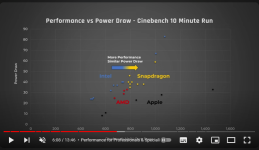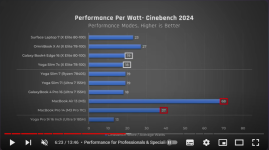Let me know when there's any actual reputable written reviews from big name sites, like the toms hardware, tech spot, techpowerup, guru3d s of the world etc rather than products carefully seeded to "random" YouTubers for crappy video "reviews"Meanwhile these devices seem to be reviewing better with people who are going a bit more in depth than running emulated games on a youtube vid. Funny that.
-
Competitor rules
Please remember that any mention of competitors, hinting at competitors or offering to provide details of competitors will result in an account suspension. The full rules can be found under the 'Terms and Rules' link in the bottom right corner of your screen. Just don't mention competitors in any way, shape or form and you'll be OK.
You are using an out of date browser. It may not display this or other websites correctly.
You should upgrade or use an alternative browser.
You should upgrade or use an alternative browser.
Snapdragon X Elite Reviews
- Thread starter Mesai
- Start date
More options
Thread starter's postsQualcomm will be adding drivers to the kernel but as mentioned above, works fine in WSL.Have any of the reviews covered ARM support and situation for these chips on GNU/Linux operating systems?
Is it though? This is just a myth that keeps being regurgitated.x86 is inherently less efficient
Latest leaks show Lunar Lake is very strong at 15w, 17w and 30w. Obviously we'll have to wait for real reviews, but it's looking good for thin-n-lights.Maybe, but Intel talk up their products every year and they’re never there.
Their latest mobile chips are an improvement in terms of efficiency. x86 is inherently less efficient so it’ll take a lot to compete with ARM in that space.
It takes x86 more instructions to perform a task. How the specific CPU architecture manages it is a different story, which is where the likes of AMD or Intel can close the gap.Is it though? This is just a myth that keeps being regurgitated.
Possible that some instructions are slower on ARM but for general use Apple have already proven it’s the better option. Outside of gaming, and assuming they don’t use some obscure software with no native build, there’s no real need for the general consumer to buy x86.
That’s not true. ARM uses a much simpler ISA, so if anything, it will be the exact oversite of that. This is why x86 uses more power, it must support a much larger instruction set. Having the extra instructions does increase performance though.It takes x86 more instructions to perform a task.
Yea sorry, meant x86 has a richer ISA whereas ARM uses a simplified and probably less flexible ISA, so there would be cases where a set of ARM instructions is less efficient, but the physical advantage allows it to use less power and generate less heat.That’s not true. ARM uses a much simpler ISA, so if anything, it will be the exact oversite of that. This is why x86 uses more power, it must support a much larger instruction set. Having the extra instructions does increase performance though.
Can I be honest, I find those outlets not being great at reviewing these types of devices and actually do a bad job even at reviewing m series mac's.Let me know when there's any actual reputable written reviews from big name sites, like the toms hardware, tech spot, techpowerup, guru3d if the world etc rather than products carefully seeded to "random" YouTubers for crappy video "reviews"
Have any of the reviews covered ARM support and situation for these chips on GNU/Linux operating systems?
Josh and his team tried a native Linux install on their livestream, but immediately ran into issues. Alex Ziskind ran up a complete dev. environment including WSL 2 and toolchains that had native ARM support.
Linux is coming according to Qualcomm
This SL7 is yielding far more battery life for than any previous laptop thats come into our office and far cooler. Yet to hear the fans even with discord video chats (Emulated) and teams video cons. And the performance is better. We dont do all core loads, so maybe there is a scaling issue with power. But for office work, its amazing. Walks over AMD and Intel and is very much Apple silicon like.I've watched literally every review that's out there - all from respected reviewers. General consensus is that X Elite is "OK", but not much better both on and off battery than many of the chips Intel and AMD already ship. From Just Josh:
At high power draws, these Snapdragon laptops offer the same power efficiency as Intel’s current Core Ultra. They do reach this diminishing marginal returns point at slightly higher power draws though. This makes them only incrementally better than those with Intel and far behind Apple’s M3 MacBooks.
None of these new laptops come close to the CPU performance offered by larger laptops with Intel, AMD, or Apple's highest end chips. This is especially so for graphics. In gaming or 3D rendering, these laptops just aren’t going to cut it.
The reviewers all state that they tested the gaming performance only because Microsoft and Qualcomm made such huge claims for it - claims that no one can seem to replicate. Funny that.
I dont need a reviewer doing gaming benchmarks on a none gaming SoC to tell me how it performs. I am writing this post on a Snapdragon X Plus, I know how its performing first hand. Which is very different to some reviews. Even reviewers cant seem to agree with each other. Maybe different Manus have config their laptops differently, idk.
Last edited:
Maybe many rushed reviews before updating etcLet me know when there's any actual reputable written reviews from big name sites, like the toms hardware, tech spot, techpowerup, guru3d if the world etc rather than products carefully seeded to "random" YouTubers for crappy video "reviews"

Surface Laptop 7 review: A new era for Windows laptops
The incredible battery life and efficient performance in Microsoft's Surface Laptop 7, powered by Qualcomm's Snapdragon X Elite chip, come at a cost.
Last edited:
It's down to differing default Windows power settings. Alex Ziskind, for example, discusses it in all three of his Elite X videos.Even reviewers cant seem to agree with each other. Maybe different Manus have config their laptops differently, idk.
It's down to differing default Windows power settings. Alex Ziskind, for example, discusses it in all three of his Elite X videos.
Yeah its down to the manu to adjust their own setting for each Windows power setting. For example, on Windows recommend mode and on battery, SL7 scores 22xx ST on an X plus variant and the Galaxy book4 edge scores 18xx or even lower on the stronger X Elite variant. This is why reviews are all over the place between different laptop brands.
My SL7 is now burning 7%ish battery an hour of heavy office work while maintaining the above Geekbench ST performance at 50% brightness with screen set to dynamic 120hz. Pretty decent on a 54wh battery.
Last edited:
for a first gen product they are very impressive
just hope qualcomm dont do qualcomm things and get complacement, they need to really carry on this trend and keep on building on this architecture
all we need now is windows to improve...
just hope qualcomm dont do qualcomm things and get complacement, they need to really carry on this trend and keep on building on this architecture
all we need now is windows to improve...
Lunar Lake will stop them from becoming complacent in the Windows laptop space. And Apple silicon will remain the standard against which they will be ultimately judged. Also seems Nvidia, Mediatek and Samsung want a slice of the pie once the MS/Qualcomm deal expires next year, so that'll keep them on their toes.just hope qualcomm dont do qualcomm things and get complacement, they need to really carry on this trend and keep on building on this architecture
Still, looks like QC are working on it: https://www.tomshardware.com/pc-com...poses-qualcomms-roadmap-with-v2-and-v3-models
We'll know a bit more once all of the drivers and Windows itself is in a less beta state as that would reveal any major flaws.for a first gen product they are very impressive
just hope qualcomm dont do qualcomm things and get complacement, they need to really carry on this trend and keep on building on this architecture
all we need now is windows to improve...
So far it seems like a really good attempt - hopefully they're more of an AMD, who seem to have a clear vision and roadmap for their Zen platform, and less of an Intel.
It takes x86 more instructions to perform a task. How the specific CPU architecture manages it is a different story, which is where the likes of AMD or Intel can close the gap.
Possible that some instructions are slower on ARM but for general use Apple have already proven it’s the better option. Outside of gaming, and assuming they don’t use some obscure software with no native build, there’s no real need for the general consumer to buy x86.
That’s not true. ARM uses a much simpler ISA, so if anything, it will be the exact oversite of that. This is why x86 uses more power, it must support a much larger instruction set. Having the extra instructions does increase performance though.
I'll leave this here, for those that haven't seen it before:Yea sorry, meant x86 has a richer ISA whereas ARM uses a simplified and probably less flexible ISA, so there would be cases where a set of ARM instructions is less efficient, but the physical advantage allows it to use less power and generate less heat.

ARM or x86? ISA Doesn’t Matter
For the past decade, ARM CPU makers have made repeated attempts to break into the high performance CPU market so it’s no surprise that we’ve seen plenty of articles, videos and discussions about ARM’s effort, and many of these pieces focus on differences between the two instruction set...
Essentially Arm and x86 are so similar today, any differences are not about the instruction set
Thanks for the link, was a good read.I'll leave this here, for those that haven't seen it before:

ARM or x86? ISA Doesn’t Matter
For the past decade, ARM CPU makers have made repeated attempts to break into the high performance CPU market so it’s no surprise that we’ve seen plenty of articles, videos and discussions about ARM’s effort, and many of these pieces focus on differences between the two instruction set...chipsandcheese.com
Essentially Arm and x86 are so similar today, any differences are not about the instruction set
Nice update by Josh on the current state of these machines: https://www.youtube.com/watch?v=elpeaSO0MtY
Nice update by Josh on the current state of these machines: https://www.youtube.com/watch?v=elpeaSO0MtY
So essentially the Snapdragon is almost on the exact same power/performance curve as Intel and AMD's offerings

And essentially depending on the implementation by the manufacturer, the efficiency can end up being exactly the same as AMD/Intel Laptops


